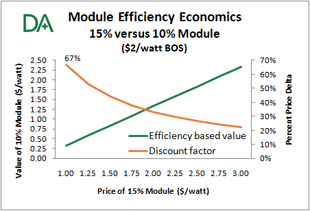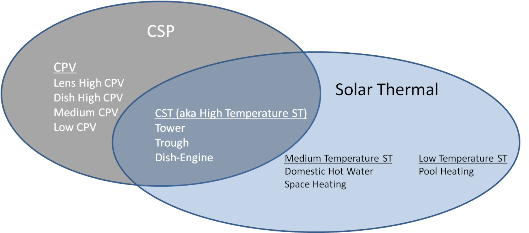
"Solar Energy is a clean and free natural resource, available to the mankind. The effective use of this un-tapped energy resource has huge potential to develop every corner of the globe, and establish a peaceful, safe and pleasant world for our future generations. It is our responsibility to start this onerous but honorable task"
Friday, October 29, 2010
Tuesday, October 19, 2010
Economics of Efficiency in PV Systems | d-bits
As prices drop, lower efficiency modules require greater price discounting

As prices drop, lower efficiency PV modules require higher discounting
Monday, October 18, 2010
Are Solar Thermal Power Plants Doomed? : Greentech Media
Again, PV is cheaper today, and expected to widen its edge over the next decade. By 2020, the CSP technologies are expected to be in the $0.10-$0.12/kWh range, whereas PV is forecast between $0.07-$0.08/kWh.
he relentless price declines of PV panels allows developers to build PV plants at a lower cost than their CST cousins. This issue is illustrated in the following Capital Cost per watt chart (an excerpt from the upcoming GTM Research "CSP Report"). In 2010, the price to build a CSP park run by Troughs, Power Towers or Dish-Engines will cost between $5.00 and $6.55 per watt (AC). On the other hand, utility-scale PV projects can limbo below $3.50 a watt (DC).
By 2020, the CSP solutions are expected to be in the $2.40-$3.80 per watt (AC) range, but by that time PV plants could be below $2 a watt (DC). Trough & Tower plants are behind PV, and not likely to catch up.
http://www.greentechmedia.com/content/images/articles/Capital%20Cost(1).pnghttp://www.greentechmedia.com/content/images/articles/LCOE(1).png


It's like that old, painful axiom in semiconductors.
Don’t bet against silicon.
PS - for a clarification on our categorization scheme, see diagram below

Wednesday, October 13, 2010
Thursday, October 7, 2010
Sri Lanka first coal power project- Norochchole Plant to go online in November | Asian Tribune
Please check on fuel cost of unit fuel cost alone is Rs 4.72/kWh
Tuesday, October 5, 2010
UNEP_GTR_2010.pdf Global Trends in Sustainable Energy Investment 2010
Analysis of Trends and Issues in the Financing of Renewable Energy and Energy Efficiency
Monday, October 4, 2010
80MW Sarnia Project Complete in Ontario Canada
80 MW Sarnia Project Complete in Ontario now the world largest PV project
http://www.solarnovus.com/index.php?option=com_content&view=article&id=1446:80mw-sarnia-project-complete&catid=41:applications-tech-news&Itemid=245
First Solar, Inc. and Enbridge Inc. have completed the expansion of the Sarnia Solar Project in Ontario, Canada from 20 megawatts (MW) of capacity to 80MW making it the largest operating photovoltaic (PV) facility in the world to-date.
The Sarnia Solar Project - 80 MW now online, represents approximately $400 million of investment and enough electricity each year to power more than 12,000 homes - or about 40 per cent of homes in the City of Sarnia. Construction of the project created about 800 jobs.